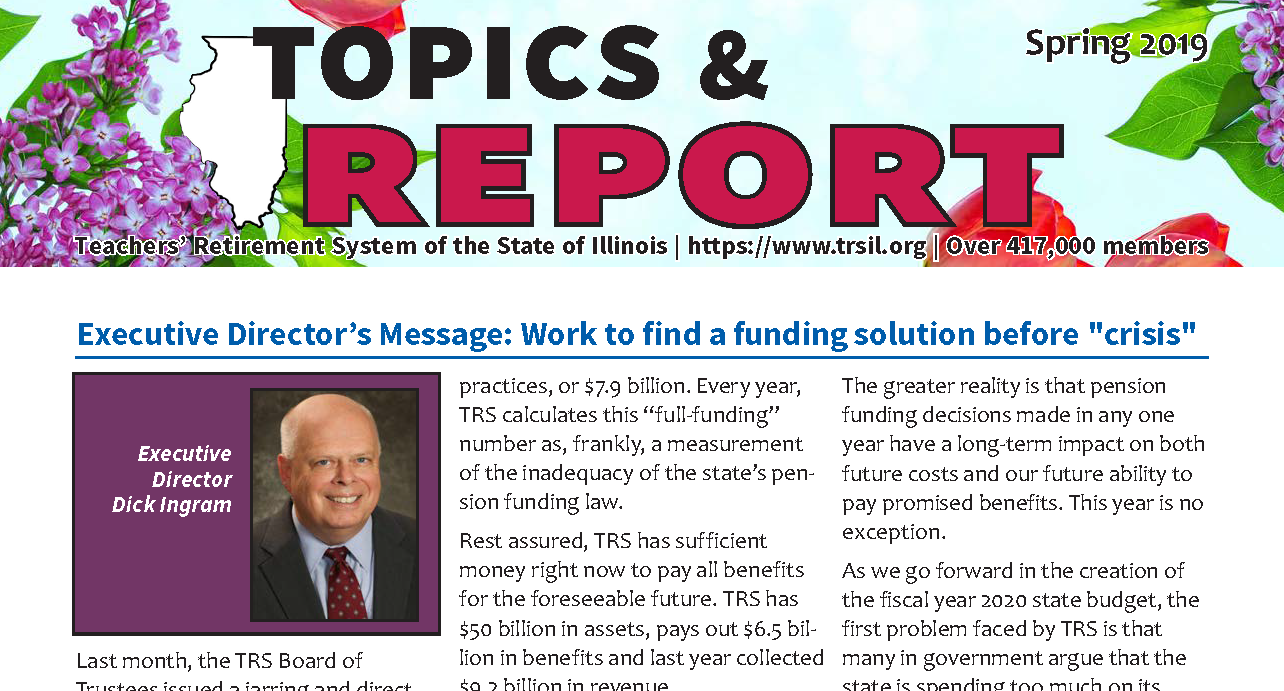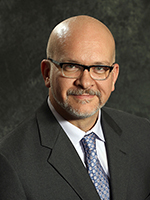Executive Director’s Message: Work to find a funding solution before "crisis"
Last month, the TRS Board of Trustees issued a jarring and direct rejection of Gov. JB Pritzker’s proposed funding amount for the System in the coming fiscal year.
After TRS members read the trustees’ statement, many we heard from were angry – and rightly so. They were primarily angry at the fact that state officials continue to disregard the dangerous condition of TRS finances and that their response is to once again deflect hard decisions further into the future.
In a nutshell, the Governor’s fiscal year 2020 state budget proposal includes a $4.238 billion contribution to Teachers’ Retirement System. That appropriation is $576 million less than the $4.814 billion contribution request certified in December by the TRS Board of Trustees. It continues an 80-year trend of “underfunding” TRS.
The sad truth is both $4.2 billion and $4.8 billion fall well short of the contribution to TRS that would be required using normal actuarial practices, or $7.9 billion. Every year, TRS calculates this “full-funding” number as, frankly, a measurement of the inadequacy of the state’s pension funding law.
Rest assured, TRS has sufficient money right now to pay all benefits for the foreseeable future. TRS has $50 billion in assets, pays out $6.5 billion in benefits and last year collected $9.2 billion in revenue.
However, TRS is very concerned that for the second time in three years, state officials have proposed a cut in the state’s annual appropriation for TRS. The trustees want to make sure that their objections are known now while the state budget is still being developed. The statement members received by email was also sent to the governor and legislative leaders.
In no way does this rejection of the pension funding levels dim my respect for the willingness of Gov. Pritzker and state legislators to wrestle with the difficulty in crafting a budget for the State of Illinois. Developing a responsible solution to the funding deficit carried by TRS is a critical part of that process – but not the only headache they have to deal with.
On the contrary, I admire anyone who is willing to be part of a solution. All of us at TRS stand ready to work with the Governor and lawmakers on our share of the task.
The greater reality is that pension funding decisions made in any one year have a long-term impact on both future costs and our future ability to pay promised benefits. This year is no exception.
As we go forward in the creation of the fiscal year 2020 state budget, the first problem faced by TRS is that many in government argue that the state is spending too much on its pension systems and that amount has to be reduced. In fiscal year 2019, the state will contribute $4.47 billion to TRS. The fiscal year 2020 amount should be $4.81 billion. Any way you look at that, the TRS allocation is a significant share of the overall state budget – 11 percent.
A second problem is that our funding level hovers around 40 percent. TRS had $52 billion in assets at the end of fiscal year 2018. Our accumulated liabilities stood at $127 billion. Our unfunded liability was $75 billion. During my time at TRS our funded status has actually declined from 46.5 percent, despite the fact that the System’s investments continue to outperform. Our 40-year rate of return is 9.2 percent, versus a current expectation of 7.0 percent.
A third problem is that the pension funding formula embedded in state law actually requires the state to appropriate less than full funding for TRS. Every year. The statutory funding rules do not follow actuarial principles. Under current law, our funded status is not projected to even reach 50 percent for another decade.
Like matter and anti-matter, these problems cannot co-exist. TRS cannot improve its fiscal health without strong and consistent state funding over the next several decades. But strong and consistent funding is impossible to sustain because the cost is already very high and the current funding formula demands inadequacy.
Left alone, this situation will lead to a “crisis.”
Our current 40 percent funding level is perilously close to impeding our ability to invest as successfully as we have in the past. As the statutory formula continues to deflate our funded status, we will need greater liquidity in our portfolio in order to make sure we always have enough cash on hand to pay benefits. Greater liquidity in the portfolio means shedding more lucrative long-term investments. And as a result, our overall return will decrease. TRS benefits are expected to total $6.8 billion in the current fiscal year and to reach $7.6 billion in three years.
Another consequence of any funding shortfall today is that the future cost to fund the System increases by roughly 2.5 to 3 times for every dollar not paid in a timely manner.
TRS cannot earn an investment return on contributions we never receive. This fact leaves future taxpayers to replace the lost investment earnings with more tax dollars. That is why today roughly 75 percent of the annual taxpayer contribution to TRS is not dedicated to paying for the cost of benefits but for the cost of prior funding shortfalls and lost investment earnings.
I try to avoid overworked clichés when talking about the financial problems facing TRS. I simply note that pension math in Illinois is unforgiving and the various problems we face are dangerously incompatible.
The proposed state budget would have taxpayers in fiscal year 2020 pay $4.2 billion of this year’s cost. Taxpayers in the future, including some not even born yet, will be on the hook for $8 billion to $11 billion just to pay the balance due for this year.
We need to find a workable solution now to the problems facing TRS before we reach a point where there is no longer a debate about when TRS is in “crisis.”
Sincerely,
Dick Ingram
TRS Executive Director
Spring TRS Board Election for One Annuitant and Two Teacher Trustees
This spring, active and retired TRS members will elect three members to the System’s 13-member Board of Trustees.
Two “active member” trustees will be elected solely by active TRS members. One “annuitant member” trustee will be elected solely by TRS annuitants.
The election is governed by the Pension Code and TRS administrative rules.
Election day is May 1. Members will cast ballots either online or by mail beginning on April 1 and up until 10 a.m. on May 1. The elected trustees will serve four-year terms beginning July 15, 2019.
TRS is not endorsing or supporting the election efforts of any of the candidates.
Inactive TRS members are not eligible to vote.
Members who are eligible to vote and have an email address on file with TRS have received an email alert directing them to their online Member Account if they wish to vote. Members without an email address on file with TRS received a paper ballot in the mail at the end of March/beginning of April.
Under the Pension Code, six members of the 13-member TRS Board are elected by members – four by active members and two by annuitants. They all serve staggered four-year terms. Six members are appointed by the governor to serve staggered four-year terms. The 13th member, the president of the Board, is the state superintendent of schools under state law.
Annuitant (Retired) Board of Trustee Candidate Profiles - Annuitants Vote for One
Cinda Klickna
I am running for the annuitant position on the TRS Board and bring knowledge and experience to the role. I have served the past 16 years on the TRS Board as an active teacher. I know the issues and have served on all committees of the board. I currently serve on the Rules and Personnel Committee, as chair of the Legislative Committee and as vice president of the board, elected by the other trustees.
I have a deep knowledge about the many facets of the TRS System and take the role of a trustee seriously to ensure retirees are supported by the promise of a pension that the state made decades ago.
I am the longest serving member of the Board, one person has five years and the rest have one to two years.
My re-election would provide continuity and knowledge about the many aspects of the role of a trustee. I would be able to help new trustees learn the terminology in investments and understand the roles and responsibilities of a trustee as well as background in issues our pensions have faced and actions our trustees have taken.
I taught high school English in Springfield, and throughout my 46‐year career, always advocated for teachers and public education. I served on the Illinois Education Association (IEA) and the National Education Association (NEA) Boards. I was elected secretary‐treasurer of IEA in 2005, and elected president of IEA in 2011, retiring from that position in 2017.
I am also a freelance writer and serve on several boards: Illinois State Museum Society, Illinois State Historical Society and Illinois Educators’ Credit Union. My husband Kim is a retired music and band teacher. We have two sons, Keith and Kevin (wife Paula) and one grandchild.
Doug Strand
I recently finished 40 years of service as an lllinois educator at United Township High School located in East Moline. I grew up on the south side of Chicago and graduated from D. D. Eisenhower High School located in Blue Island.
I finished a Bachelor of Arts degree from Luther College in Decorah, Iowa. Later, I went back to school to get my teaching degree from the University of Minnesota in Minneapolis. After teaching a few years, l finished a Master of Science degree in educational administration and supervision from Western Illinois University in Macomb.
Over the years, I enjoyed playing softball and golf, bike riding, reading, fishing and going "up north" in the summers to Hayward, Wisconsin, where I have had a place since 1995. This past year, I visited Portugal and Santa Fe, New Mexico besides going up to Hayward several times.
In the last 40 years, I have served on various boards including a teacher's established credit union called Service Plus Credit Union, East Moline Youth Baseball, Black Hawk College of Trustees (twice), East Moline City Council, East Moline Police Pension Board and the local unit of the IRTA.
I look forward to representing the IRTA on the TRS Board and visiting local units to encourage membership in this organization (IRTA) that protects retired educators' pensions and benefits.
Active Teacher Board of Trustee Candidate Profiles - Active Teachers Vote for Two
Marsha Byas
I have lived in Southern Illinois for over 30 years and have had the privilege of teaching third-grade special education for 20 of those years. In addition to teaching, I have also owned two small businesses. My business experiences have allowed me to become knowledgeable of state and federal laws, payroll, insurance and investments. I use this knowledge as Harrisburg's IEA union president and as a member of the union’s negotiating team.
Currently, I serve as the IEA Region 1 Grassroots Political Activist as well as the region secretary. Locally, I am on our building leadership team, district leadership team and a member of Southern Illinois Resiliency. These teams are responsible for guiding our district and creating an atmosphere of trust and transparency for all stakeholders.
I also participate in IEA’s Ed-Communities to increase my knowledge of cultural issues, advocating for teachers and students as well as developing myself professionally. As the Board of Trustees stands today, the composition of the elected trustees does not include ethnic minority representation or representation from Southern Illinois. It is important that the board represents cultural and geographic diversity. By doing so, the board would be a true reflection of the totality of its members.
Kathleen (Kathy) Hinz
I am the daughter of a high school teacher and administrator. I grew up in Northern Illinois living in Woodstock, Dixon, Fulton, and Freeport prior to attending college at Western Illinois University. After college, I settled down in Crystal Lake, which is where I currently live with my husband and daughter, who is currently a freshman in college.
I have a specialist degree in school psychology, master's degree in educational leadership and a doctorate in educational leadership. Currently, I serve in the role of superintendent for Crystal Lake Elementary District 47. Prior to this role, I worked in District 47 as a school psychologist, director of special education and asst. supt. of student services and professional development.
Currently, I am a member of the Illinois Principals Association, Illinois Association of School Administrators, Illinois Association of School Board Officials and American Association of School Administrators.
I am seeking a seat on the TRS Board of Trustees to continue to advocate for educators. I feel that my experience on the operational/financial side of a school district in conjunction with my knowledge of and years advocating for legislation both in special education and general education areas would be beneficial on the TRS Board of Trustees.
Andrew Hirshman
I am a current trustee and would be honored to continue to serve in this capacity. As the current chair of the TRS Investment Committee, I was selected by the trustees to coordinate board oversight of the 50 billion dollar TRS portfolio. I have also served as a member of the Audit and Legislative Committees. I am a proud member of the Illinois Education Association.
I teach economics and world history at Mundelein High School. I am a graduate of both the University of Michigan and Northwestern University, where I have also worked as a teacher educator for the past 15 years. I live in Oak Park with my wife and three children.
I am a former member of the IEA Board of Directors and served as a pension trustee on the IEA’s professional staff pension plan. In both of these roles, I gained the knowledge and experience needed to monitor the financial conditions of these plans, analyze their funding percentages, recommend asset allocation strategies, and all the while overseeing compliance with state and federal regulations. In my work as an educator, I have represented the Federal Reserve Board, the Department of State and the U.S. Department of Education on issues relating to economic education on three different continents.
A strong system of public education is strengthened by a strong defined benefit pension system. My experience as an educator, trustee and as a board member for numerous organizations has prepared me to fight for the retirement security of all Illinois TRS members.
New State School Superintendent/TRS Board President Sworn In
In late February, Dr. Carmen I. Ayala was sworn in as the new Illinois State Superintendent of Education, a post that automatically carries with it the permanent presidency of the TRS Board of Trustees.
Dr. Ayala is the 30th state superintendent in Illinois history and was selected by the Illinois State Board of Education (ISBE) and Gov. JB Pritzker. Until her selection to lead ISBE, Dr. Ayala had served as the superintendent of Berwyn North School District 98 in the Chicago suburbs.
She has more than 30 years of experience in public education and holds a PhD. from Loyola University in Chicago. Dr. Ayala previously served as assistant superintendent at Plainfield Community Consolidated District 202, as a director at Community Unit District 300 in Algonquin, as assistant superintendent and director of bilingual services at East Aurora School District 131 and as a classroom teacher in the Chicago Public School system.
In addition to the mountain of duties she has assumed as state superintendent, state law designates Dr. Ayala to serve on the TRS Board as its 13th member and permanent president at all meetings. Of the other 12 board members, six TRS trustees are elected by members and six trustees are appointed by the governor.
Counselors Hit the Road This Summer for Tier 2 “Bring TRS to You”
TRS will begin a pilot project called "Bring TRS to You" that expands our outreach to Tier 2 members who live far away from our Springfield and Lisle offices.
Tier 2 members first contributed to TRS on or after Jan. 1, 2011 and have no pre-existing creditable service with a reciprocal pension system prior to Jan. 1, 2011.
The State of Illinois covers 55,000 square miles and many members, especially in Southern, Western and East- Central Illinois, find that making an appointment with a TRS counselor equals a full day of travel for a half-hour meeting. In addition, family needs and work schedules can compound the logistics of a trip to our offices.
TRS counselors will travel to designated locations throughout the state for three-day periods to meet with members. The counselors will have full access to all TRS record systems and these sessions will operate just as if the members had traveled to TRS for a counseling appointment.
Because of the limited hours available during each three-day visit, all sessions will be scheduled before the counselor arrives. TRS will notify all Tier 2 members about the sessions in advance with a special email alert that will include the location, times and a way to make an appointment.
TRS will evaluate the initial round of “Bring TRS to You” sessions to see if they should become a regular fixture on the TRS calendar or expanded in order to meet the needs of more members. These new sessions are not designed to replace the popular Large Group Meetings that TRS sets up every fall in schools throughout the state.
Schedule
- Rock Island – June 18, 19, 20
- Macomb – June 25, 26, 27
- Edwardsville – July 9, 10, 11
- Marion – July 16, 17, 18
- Rockford – July 16, 17, 18
- Effingham – July 23, 24, 25
Benefit Choice Period for Health Insurance Coverage Planned in May
The annual Benefit Choice Period for Teachers’ Retirement Insurance Program (TRIP) participants is planned for May 1 through May 31, 2019. TRS will post any updates about the Benefit Choice Period on our website.
This Benefit Choice Period is not for members currently enrolled in the State of Illinois Medicare Advantage Plan - Total Retiree Advantage Illinois (TRAIL). The Benefits Choice Period for TRAIL participants will be held in the fall.
Benefit Choice is the time to make changes in TRIP coverage and to enroll yourself and eligible dependents.
A new law allows TRS members and their dependents who have previously opted out of the Teachers' Retirement Insurance Program (TRIP) to re-enroll in the program if they wish. Re-enrollment is allowed only during the annual open enrollment period or for other qualifying enrollment opportunities.
The information about the Benefit Choice Period will be mailed to retirees currently enrolled in TRIP at the end of April.
The mailing will include an explanation of health insurance options for the coming year and changes in coverage benefits.
The full Benefit Choice booklet will be available at http://www.benefitschoice.il.gov (the Illinois Department of Central Management Services [CMS] website) and also on MyBenefits.illinois.gov.
If you already are enrolled in TRIP and wish to make a change in coverage, call MyBenefits Service Center (MBSC) at 844-251-1777 or log in at MyBenefits.illinois.gov. If you are enrolling yourself for the first time during the Benefit Choice Period, please contact TRS for a TRIP Participation Election form.
If you do not want to change your coverage, you do not have to do anything. Your current coverage will continue.
TRS does not administer TRIP. As a reminder, TRS determines eligibility, assists with enrolling members in the program and collects appropriate premiums. By law, CMS is the administrator that determines coverage benefits, establishes premiums, negotiates contracts with the insurance carriers, and resolves coverage and claim issues.
MBSC is the custom benefits solution service provider for CMS and can answer questions about changing coverage or electing benefits.
Update for Retiring Tier 1 and Inactive Member “Buyout” Programs
Gov. JB Pritzker’s office borrowed an initial $300 million this spring to fund a new “Accelerated Annual Increase” (AAI) program for retiring Tier 1 members and a buyout program for inactive members.
Once the money is deposited with the state comptroller’s office, members who sign up can expect to receive their lump-sum payouts shortly thereafter.
The governor’s office plans to borrow $700 million more to fund the “buyout” programs over the summer.
TRS implemented the AAI Program in December 2018 and is working to start the “buyout” program for all eligible inactive members this summer.
Under the AAI Program, TRS is required to offer retiring Tier 1 members an accelerated pension benefit payment at the time that they apply for their pensions.
Tier 1 members who choose to accept the AAI Program will renounce their rights to their current annual pension increase – a 3 percent raise calculated from the amount of their current pensions. Instead, they receive a 1.5 percent raise always calculated from the amount of their original pensions.
The lump-sum “accelerated pension benefit payment” equals 70 percent of the monetary difference between the estimated current lifetime value of the 3 percent annual raise and the estimated current lifetime value of the 1.5 percent annual raise.
For participants in the AAI program, the new raise would take effect on the Jan. 1 after the member turns 67 or the first anniversary of the member’s retirement, whichever is later. The existing 3 percent annual raise begins on the Jan. 1 after the member turns 61 or the first anniversary of the member’s retirement, whichever is later.
Under the second buyout program, TRS will offer all eligible inactive members in both Tier 1 and Tier 2 this summer a chance for a one-time payment that equals 60 percent of the present value of the member’s anticipated pension benefits.
Members accepting the accelerated payment give up any future claim to a TRS benefit.
Members joining either buyout program will be able to receive their accelerated pension benefit payments as cash or as a “rollover” into a private tax-qualified retirement plan. If a member takes the payment as cash, it will be subject to all applicable taxes and charges.
Both buyout programs will exist until June 30, 2021.
Prepare for Retirement by Using This Tier 1 Retirement Time Line Checklist
As Soon as Possible
If you have not already submitted a “proof of birth” online in the Member Account Access area, it must be provided to TRS in order to process your retirement benefit.
Update your years of service. Obtain the cost of reinstating a TRS refund, record sick leave from former employers and report optional service. Types of optional service include:
- substitute teaching,
- homebound or part-time service before July 1, 1990,
- out-of-system service,
- military service,
- board approved leaves of absence,
- leaves of absence due to pregnancy or adoption prior to July 1983, and
- involuntary layoffs.
Update your Member Information and Beneficiary Designation (MIBD) form to ensure that survivor benefits will be paid according to your wishes.
Provide us with your home email address in the secure Member Account Access area. Emails about legislation and other important events will also be sent as needed.
Review the TRS Tier I Member Guide.
Inquire about upgrading your pre-July 1998 service to the 2.2 formula. Call us for the cost to upgrade.
Consider consulting with a financial planner. TRS does not provide financial advice.
Determine if any reciprocal service you have accrued will be beneficial to use in retirement. Each retirement system has specific rules about reinstating refunded service.
4 to 5 Years Before Retirement
Attend a pre-retirement meeting. A schedule is available on the TRS website during the fall.
Request a benefit estimate online in the secure Member Account Access area or by calling us. We will need to know your estimated retirement date; the number of unused, uncompensated sick leave days at retirement; and current and estimated future salary rates, including TRS contributions. Also include any bonuses and extra-duty pay.
2 Years Before Retirement
Request an updated benefit estimate (online or by phone).
Attend a pre-retirement meeting.
Finish reporting all optional service; this task may take time and research.
Complete payment to reciprocal system for refunded service, if applicable.
6 - 12 Weeks Before Retirement
Complete the Personalized Retirement Interview by calling us or logging on to the Member Account Access area of our website. You’ll be asked a few questions that will complete information in the retirement packet. You will receive the packet within 15 working days. If you have reciprocal service, you also will need to call the other retirement system(s)to apply.
Be certain you have provided us with your home email address in the secure Member Account Access area online. You will receive important information about the status of your retirement via email.
Check on the status of any optional service or 2.2 balances still owed. During the retirement process, you will be asked how you wish to pay any remaining 2.2 balance.
Payment can be made either through a lump sum, rollover, or pre-tax reduction from your monthly annuity check. If you have any optional service balances, they must be paid prior to retirement, with the exception of pregnancy or adoption leaves.













